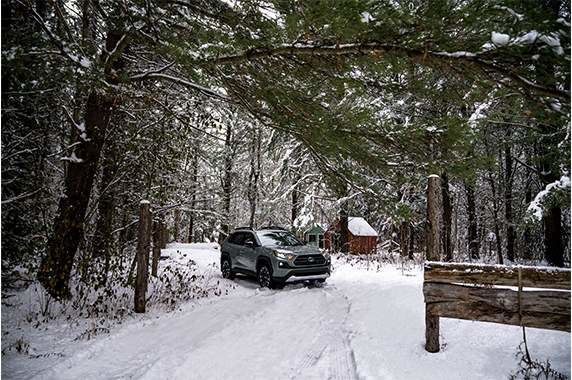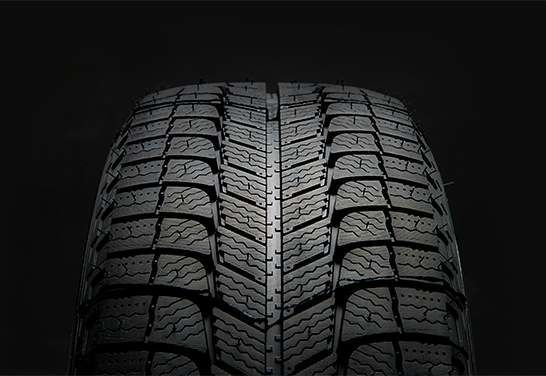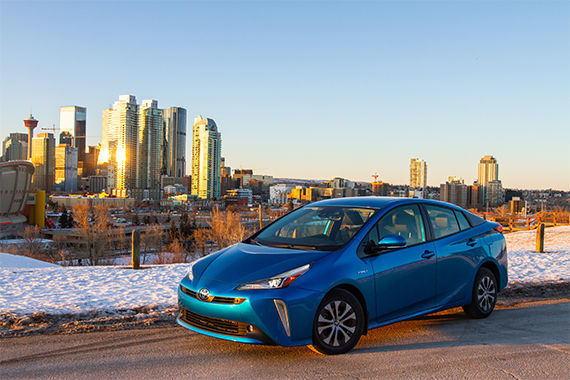Select a province & language
Entrance to this website assumes you have read and agree to these Legal Terms and Conditions and the Privacy Policy.
Entrance to this website assumes you have read and agree to these Legal Terms and Conditions and the Privacy Policy.

When Canadian winter decides to show its nasty side, drivers face all sorts of surprises and challenges. In 2017, there were over 20,000 weather-related crashes in Canada.* But with a little preparation, allowing yourself some extra time, and some small changes to your driving habits, you can take the worry out of winter driving. So here are some valuable tips to give you the confidence to actually enjoy winter in Canada.
The Boy Scouts may not be talking about winter driving. But they could be. When the mercury dips below 7˚C, it’s a good idea to switch to winter tires. Not only do they provide better traction in slush and snow, winter tires’ softer rubber compound is designed to grip cold surfaces much better.
Once you get your winter tires on, we also suggest you get a duffel bag and fill it with things like jumper cables, a flashlight, an extra scraper, a jug of Toyota Genuine windshield washer fluid, a blanket, some heat packs, plus flares or emergency lights in case you do get stuck. It’s also a good idea to keep your fuel tank at least half full at all times. And check your tires’ tread and inflation every week or so. For electric vehicles and PHEV (plug-in hybrid electric vehicles), err on the side of caution and always plug in overnight. It’s also wise to pre-heat the inside compartment before unplugging in the morning. And it’s never a bad idea to get your vehicle thoroughly inspected by experts at your nearest Toyota dealership.

When it comes to estimating how long it takes to get somewhere, our brains are adorably optimistic. But driving safely in the winter simply takes more time than we want to believe. Whatever your map app tells you, add at least 10 or even 15 minutes. Why? Lots of reasons. Like the time you need to clear all the snow and ice off your vehicle (nobody remembers that!). Or the fact that snowy and icy conditions demand that we drive slower. And as we all know, driving in a hurry in the winter is basically asking for trouble. In fact, let’s talk about some specific tips for driving in the winter.
Experienced winter drivers will tell you there are some specific things you do differently on winter roads. The most basic is driving a little slower on snow and ice. Another trick is to accelerate and decelerate more slowly; trying to speed forward from a stop will just make you skid. Slamming on the brakes will do the same. So it’s important to slow things down.
Tailgating is bad, right? Well in the winter, it’s downright foolish. It’s best to increase your following distance to 5-6 seconds. On your commutes, you’ll probably have some drivers who squeeze right into that space. Our strong recommendation is to just ease back and give yourself that 5-6 second buffer again. You didn’t just lose time, you actually gained it: tons of studies show that leaving more space behind cars actually speeds up traffic.
Hills are another place where you need to ‘winter drive’. When you approach the bottom of a hill, get a little inertia and try to ride that to the top. Extra gas on a hill just gets your wheels spinning, and that’s no good. A soft touch on the pedal is even more important when you’re going downhill. A quick internet search of ‘car winter hill’ will show you all you need to know about the importance of taking it slow on a downhill slope. So make sure you give yourself a whole lot of stopping distance.
It happens to even the most experienced drivers. But with these helpful tips, getting stuck will just be an annoyance, not a danger.
Remember that handy-dandy winter duffel bag you prepared a few paragraphs ago? Give yourself a pat on the back for actually doing it. In these situations, staying warm is paramount. So is staying visible to other drivers and possible rescuers. You’ll be very thankful for those flares or emergency lights.
One common mistake a lot of drivers make is to leave their car. Don’t. Your vehicle is a big insulated cage that will keep you warm and safe from other cars or trucks. Even in a severe storm, stay in your vehicle. It’s easier than you think to lose sight of your car and get lost.
Another thing we mentioned earlier is to keep your fuel tank half full. This is exactly why: now you can use your car’s heater to keep you warm for a time. But try to conserve your fuel, and only use it enough to take the chill out of the cab of your vehicle. And before you do run your engine while stuck, make sure your exhaust pipe is clear of snow. A clogged pipe can cause carbon monoxide to leak into your vehicle when it’s running.

As you can see, safe winter driving takes a little extra preparation, patience and effort. But if you respect the conditions, follow these valuable tips, and keep your Toyota maintained by our expert technicians, you’ll drive with the confidence and peace of mind to get out there and enjoy this incredible country. See you out there!